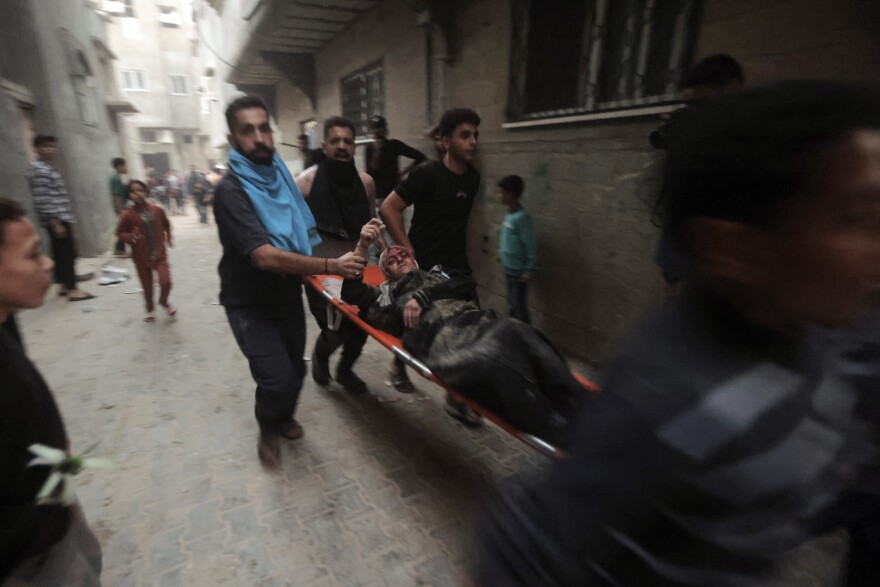Updated November 18, 2023 at 11:45 AM ET
Israeli bombardment has killed thousands of civilians in the areas of the Gaza Strip that Israel has ordered them to move to, Gaza health ministry death tolls show. Witnesses' accounts, satellite data and expert assessment gathered by NPR show that Israeli airstrikes and artillery fire occur daily in the areas Israel has said are "safer" for civilians, and have hit schools, residential towers and overcrowded United Nations refugee shelters.
Amid its military offensive on Gaza City and the northern Gaza Strip, the Israeli military has repeatedly dropped leaflets and sent messages telling residents they must leave their homes and "evacuate" to areas it claims are safer, which are south of the Wadi Gaza wetlands.
Families have risked journeys through the blasted landscape of destroyed buildings and corpses, along the road that Israel has designated as a "" through the war. For the few hours each day that the road is open, people carry or drag wounded loved ones. They push wheelchairs with patients just out of surgery in hospitals that have now stopped working. Mothers pull along weary children who look around with blank, fearful stares.
But what awaits Palestinians who move south is still life-threatening. The "evacuation" areas are both heavily bombarded and in a dire humanitarian crisis, as Israel's blockade of fuel and control of aid into the Gaza Strip leaves people searching for food and access to clean water.
"Israel's use of the term 'evacuation' for sending Palestinians to southern areas is really problematic, because it conjures up an idea of a safe route to a place of safety," says Caitlin Procter, a research fellow at the Center on Conflict Development and Peacebuilding at the Geneva Graduate Institute. "But the reality is there is no safe place left in Gaza for people to go."
More than 3,600 people have been killed south of Wadi Gaza
Israel has vowed to defeat Hamas and force an end to its rule of Gaza after the Oct. 7 attack in which Hamas-led militants killed 1,200 people in Israel and took more than 240 hostages, according to Israeli officials.
The Israeli military says it will strike Hamas targets "wherever necessary." So far, Israeli airstrikes have hit residential buildings, bakeries, hospitals and even United Nations-run shelters across the heavily populated Gaza Strip, including in the south.
The Israel Defense Forces press desk, responding via WhatsApp to questions from NPR, said on Nov. 9 that it is operating to protect the security of the state of Israel after the Hamas attacks.
It said it "continues to request that all residents move south, where it is considered to be safer than the northern Gaza Strip." But, it says, because "Hamas has embedded itself in civilian infrastructure and operates across the entire Gaza Strip," the IDF "will strike Hamas wherever necessary."
Earlier this week, telling residents in parts of the southern town of Khan Younis they too had to leave their homes. The IDF did not respond to NPR's request for comment on this further displacement of civilians.
The dangers for those fleeing south are evident from the high number of people killed there. So far, a total of more than 11,800 people — of which more than two-thirds are children, women and elderly — have been killed in Gaza since Israel launched its military offensive last month, according to Gaza's Health Ministry. , relying on the health ministry's data, shows that more than 3,600 people — roughly one-third of the total — were killed in areas where Israel has told civilians in northern Gaza to escape to.
Satellite imagery shows an increase in damage to central and southern Gaza since Oct. 13
Loading...
The latest analysis of imagery from the European Space Agency's Sentinel-1 satellite shows a steady increase in the number of buildings destroyed in middle and southern Gaza. Since the beginning of the conflict, over 10,000 buildings are likely to have been damaged or destroyed by airstrikes in these areas, according to analysis by Corey Scher of New York's CUNY Graduate Center and Jamon Van Den Hoek of Oregon State University.
As NPR has , the same satellite analysis shows extensive destruction in northern Gaza, according to Scher and Van Den Hoek.
The majority – 94% – of the damage to central and southern Gaza appeared after Oct. 13, when the Israeli military ordered the evacuation of northern Gaza. Since Oct. 30, between 3,400 and 4,800 additional buildings have been destroyed or damaged in this so-called evacuation zone, including in the heavily populated refugee camps of Bureij and Al-Maghazi. On Tuesday, Israeli airstrikes hit a densely populated residential area in Khan Younis, killing at least 14 people.
Several have noted bombardments also hit residential buildings in the Nuseirat refugee camp and , both in central Gaza.
For one family seeking safety in the south, "death came"

Asa'd Saqallah told NPR his family fled Gaza City when his father received a call from the Israeli military saying they had to leave their home and move south. On Oct. 13, he and 16 relatives, including his adult siblings and their children, took what few possessions they could and went to stay with a cousin in Khan Younis, in the south of the Gaza Strip.
Eleven days later, at night on Oct. 24, most of the family were sleeping when, Saqallah says, "Death came." In a multiple rocket attack, Saqallah says, the walls of their apartment caved in on them, and the apartment above in the three-story building was destroyed. "I started praying; rubble fell on me; my face was burnt," he says.
Saqallah says his 11-month-old son was killed. So was his sister, her husband and their three children, ages 12, 8 and 6 months. And so was his younger brother, 18, and a cousin.
Saqallah's wife, who was heavily pregnant, was badly wounded. "When I carried her out of the building, her arm was gone and her legs were just flesh," he says. Doctors managed to save her and the baby girl that she has now delivered — named Mariam after Saqallah's dead sister.
Saqallah, 25, says baby Mariam has given them a reason to live. But they remain broken. "There is no emotion, no life, no feeling," he says. "After everything that has happened, and we're sitting in the hospital now, how do you want us to feel?"
Bombing has increased in places where Israel told Palestinians to flee
An analysis by the civilian harm watchdog Airwars shared with NPR finds that in the first week after Israel began telling civilians to move south, the bombardment on these areas increased. The increase was part of intensified airstrikes across the Gaza Strip.

The group parsed every report of harm to civilians south of Wadi Gaza in the first week after Israel told civilians to go there. Including only those events they could geolocate, Airwars gathered 127 allegations of civilian harm between Oct. 14 and Oct. 21.
"You can see that the frequency and intensity of those allegations of the attacks south of Wadi Gaza really appeared to increase," Sanjana Varghese, a journalist who also works as an investigator at Airwars, says of the group's as-yet unpublished analysis.
The strikes on the south were part of a pattern of increased Israeli bombardment across the whole Gaza Strip, Varghese says. Many of the reported attacks Airwars analyzed in the south were around civilian infrastructure, including schools, hospitals and restaurants.
"Calling this area an evacuation zone might technically be true," says Varghese. "But it's not safe. It's not a place that people can go to and know that they'll be taken care of."
Most attacks on U.N. shelters have occurred in the south
Last Sunday, Israeli strikes included an from UNRWA, the U.N. relief agency that aids Palestinians, in the southern town of Rafah, on the border with Egypt. In this case, the employees had just left the building and were not injured. But in the past five weeks, 102 UNRWA staff have been killed — more losses than during any other period in its more than 70-year history.
"Every day we get more confirmation of more colleagues killed," says Juliette Touma, UNRWA's director of communications, based in Amman. "It's shattering. It's just shattering."
Some 830,000 displaced people in UNRWA schools and other buildings. They live in cramped conditions, sleeping in the schoolyards or in hallways. In the most overcrowded shelters there are now over
UNRWA regularly shares the coordinates of its centers with the Israeli military, and civilians come to the shelters hoping they are safe. But even these have become targets. Over the last month, UNRWA says 64 of its facilities have been damaged, including several in direct strikes. It says the attacks have killed 71 people in its shelters and injured 563 more.
Over half of the U.N. agency's buildings that have come under attack are located south of the Wadi Gaza line, UNRWA says.
"This shows that nowhere is safe in Gaza. Not the north, nor the middle areas or the south," says Touma. "Civilians, including children, including women, including men, including UNRWA colleagues, have been killed across the board across the Gaza Strip."
Donatella Rovera, an investigator with Amnesty International with decades of experience covering conflicts, tells NPR the intensity of Israel's offensive on Gaza is "beyond anything we've seen." Palestinian officials in Gaza say the fatalities so far include 4,407 children, 3,137 women and 686 elderly people, out of a population of 2.3 million.
Rovera says the high number of dead shows that the Israeli military is willing to carry out strikes on Hamas targets despite the presence of many civilians. "This is why we get so many dead who are clearly noncombatants, because they are children, women, older people, people with disabilities," Rovera says.
Israel claims that Hamas militants are embedding with the civilian population and insists it has a right to carry out strikes in its effort to wipe out Hamas.
Philippe Lazzarini, the commissioner general of UNRWA, on Gaza in Paris last week that "thousands of children cannot be 'collateral damage.'"
Most displaced Palestinians are now in the south and have nowhere else to go
UNRWA says 70% of Gaza's population has been displaced in this offensive, and most are now south of Wadi Gaza, a tiny area only 16 miles long and between about three and seven miles wide at different points. In this overcrowded area, Palestinians now struggle to find shelter, food and water.
"People are gathering wood from the rubble of buildings where possible to make fires to cook over. They are searching for water, even digging holes to try to reach it," says Procter, of the Geneva Graduate Institute. Procter lived in Gaza and speaks regularly with people there.
"We can't find food and we can't find water," Abu Kareem, a resident of Rafah, told NPR this week. "And we don't have the water to shower."
Even before this war, Gaza was dependent on aid to function. After the Oct. 7 Hamas attack, Israel imposed what it has called a "total" siege on the Gaza Strip, blocking fuel and other necessities from entering.
Some aid trucks have now started moving into Gaza again, but humanitarian groups say the deliveries are not enough to match the need. Meanwhile, UNRWA says diseases are spreading.
And Palestinian telecommunications provider Paltel said this week its cell towers in the Gaza Strip had stopped operating for the lack of fuel, further cutting off residents from the outside world. On Friday, a "partial restoration" of services, after receiving "a limited quantity of fuel" via UNRWA to restart its generators.
Ruth Sherlock reported from Rome. Daniel Wood is based in Washington, D.C. Abu Bakr Bashir reported from London, where Fatima Al-Kassab also contributed to this story. Alon Avital contributed reporting from Tel Aviv. Anas Baba reported from Gaza.
Copyright 2023 NPR. To see more, visit https://www.npr.org.







